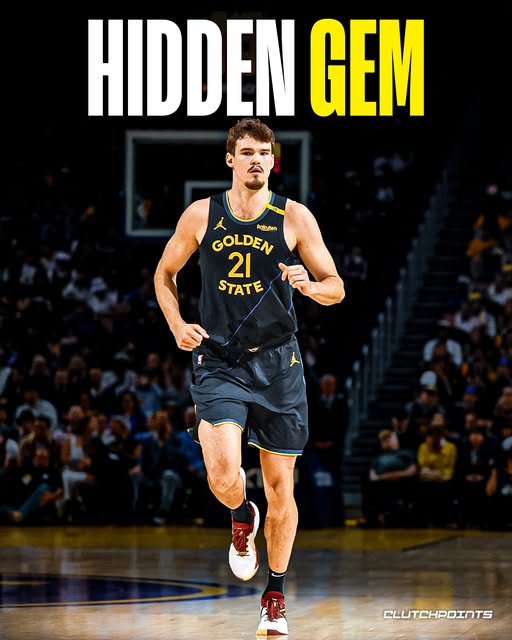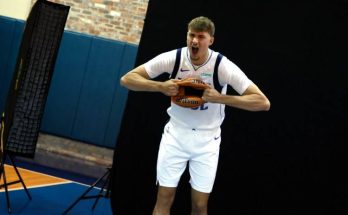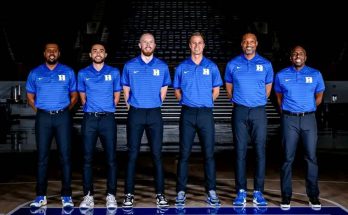Quinten Post didn’t enter last season with hype. No lottery buzz, no national spotlight, barely even a plan. He was a 7-footer buried on the depth chart, known more for his potential than his production, a towering question mark with just enough promise to stay on the roster. At best, he was seen as a desperation floor-spacer for a team starving for shooting, a stretch big with soft touch from the perimeter but little else to anchor his case. He was the type of player who enters a season with more skepticism than belief, the kind coaches hesitate to bet on and fans barely notice. And yet, somewhere between the low expectations and the crowded frontcourt, something changed.
It didn’t happen overnight. There wasn’t a single breakout game that flipped the narrative. No viral dunk, no SportsCenter highlight. But the shift was real and undeniable. Post started making shots, and not just in garbage time or in blowout losses. He began to assert himself in critical moments—hitting threes with confidence, rotating quicker on defense, making smart reads from the high post. It was subtle at first, but over time, his game began to bloom with an unassuming steadiness. He was no longer just a theoretical shooter or a matchup-specific big. He was a real piece, a contributor, someone who didn’t need to be hidden or explained.
The thing about Quinten Post is that he never demanded attention. He didn’t flex after big plays or glare into the camera. He was quiet on the court, unbothered by the noise, moving like a player who’d figured something out on his own terms. And maybe that was part of the appeal—he wasn’t trying to be a star. He was just trying to help his team win. In a landscape obsessed with raw athleticism and highlight reels, Post’s appeal was almost retro. He was a throwback to the thinking man’s big man: skilled, methodical, deliberate. Not flashy, but effective. Not a unicorn, but something just as rare—a player who knew his game and played within it.
That self-awareness became his greatest weapon. At 7 feet tall with a reliable jumper, Post could stretch the floor in ways most college bigs couldn’t. But he wasn’t content to float on the perimeter. He mixed in post-ups, pump fakes, and pick-and-pops, reading the game like a veteran guard. He developed a feel for the tempo of possessions—when to accelerate, when to delay, when to trail the play for a clean look. He wasn’t faster than his defender, but he was smarter. He didn’t jump higher, but he positioned better. Every possession became a puzzle, and Post made a habit of solving them.
As his confidence grew, so did his role. By midseason, he was more than a floor spacer—he was a fulcrum. Offenses ran through him at the elbows, where he could hit cutters or knock down mid-range jumpers. On defense, he improved his positioning, using his length to contest shots without fouling, learning to hedge and recover more fluidly. Coaches started trusting him in big moments. Teammates looked for him when things stalled. What once felt like an experiment now looked like a blueprint. He wasn’t just filling space anymore—he was shaping it.
Of course, the skeptics didn’t vanish. There were still questions about his physicality, his ability to bang with bruising centers, or hold up against high-speed guards on switches. And those questions weren’t unfounded. Post wasn’t a perfect prospect. He lacked elite foot speed, and he could still be overwhelmed by sheer athleticism. But what he lacked in raw tools, he made up for in craft. He worked angles, he anticipated rotations, and he rarely made the same mistake twice. He wasn’t trying to be dominant—he was trying to be dependable. And in a sport that often celebrates volatility, there’s a quiet power in consistency.
It’s tempting to reduce his rise to a narrative of hard work and perseverance. And yes, Post worked. He added strength, improved his conditioning, and fine-tuned his jumper. But more than anything, he matured. He grew into his game. There’s a difference between playing basketball and understanding it. Last season, Quinten Post began to understand it in a new way. He started reading defenses with patience, exploiting mismatches without forcing them, managing his fouls to stay on the court longer. His growth wasn’t loud or linear, but it was real.
The timing couldn’t have been better. With the transfer portal reshaping rosters at warp speed and NIL deals introducing new pressures, stability has become a rare commodity in college basketball. Players bounce from program to program, coaches shuffle rotations to chase upside, and continuity often gets sacrificed in the name of potential. But Post offered something else: a player who stayed, who got better, and who eventually proved he belonged not because of hype, but because of habit. That made him a quiet leader in the locker room, someone younger players could watch and learn from. His journey became a roadmap, especially for those who don’t start as five-stars or instant-impact freshmen.
By the end of the season, his name started to surface in draft circles. Not prominently—not in the lottery or even on every big board—but enough to raise eyebrows. Scouts began to take note of the skill set: a legit 7-footer who could shoot, pass, and defend in space. The kind of role player who might stick on a roster if placed in the right system. He didn’t project as a star, but stars aren’t the only ones who make it. There’s a premium in the modern game on bigs who can shoot without being liabilities on defense, who understand spacing, who know how to operate within structure. Post checked those boxes, not with flash, but with fundamentals.
That’s the thing about players like him. They don’t break through with one viral moment—they earn their place over time. They make themselves useful. They study film, they improve their footwork, they find their niche. And once they find it, they hold on. There’s something satisfying about watching a player like Quinten Post carve out a role not through talent alone, but through development. In a way, he’s proof that the system still works for those willing to stay the course.
There’s a tendency in modern basketball discourse to chase upside at all costs, to prioritize ceiling over floor, to treat experience like a liability. But Post flipped that narrative. His age became an asset, his repetitions a foundation. He didn’t need to project stardom—he needed to project stability. And he did. By season’s end, he wasn’t just a usable piece; he was indispensable. He brought balance to the roster, stretching the floor on offense while anchoring it on defense. He didn’t need 25 points a night to impact the game. Sometimes it was a quiet 12 and 8, a couple blocks, a clutch three, or a perfect outlet pass that sparked a run. Winning plays, made without fanfare.
Looking back, it’s almost funny how little was expected of him. The same scouts who once ignored him were now recalibrating their models. The same fans who barely noticed him were now defending his value in heated debates. But that’s the beauty of development—it’s not linear, and it’s often invisible until it isn’t. One season can change everything. One season of patience, growth, and quiet excellence. Quinten Post didn’t need the hype. He just needed the opportunity—and once he got it, he made sure no one could take it away.
In the end, maybe that’s the story. Not the numbers or the accolades, but the arc. The transformation from depth piece to focal point, from question mark to cornerstone. There’s power in that kind of journey, in becoming more than anyone thought you could be. Quinten Post didn’t just find his role—he redefined it. Not with theatrics, but with trust. Not with hype, but with humility. And in a sport obsessed with what’s next, he reminded everyone that sometimes the best stories are the ones still being written.



